While sometimes overlooked, a cutting board is a foundational piece of kitchen equipment. After all, it’s where almost every meal starts.
In most cases, you can keep your cutting board clean by simply washing it with soap and water. But, if your board develops any odors or stains, salting it is a great technique to get it refreshed and back in action.
You can do it once a week, once a month, or even just once a year. But for being such a frequently used and hard-working kitchen tool, every cutting board deserves a day at the spa once in a while.
In This Article
The Importance Of A Clean Cutting Board
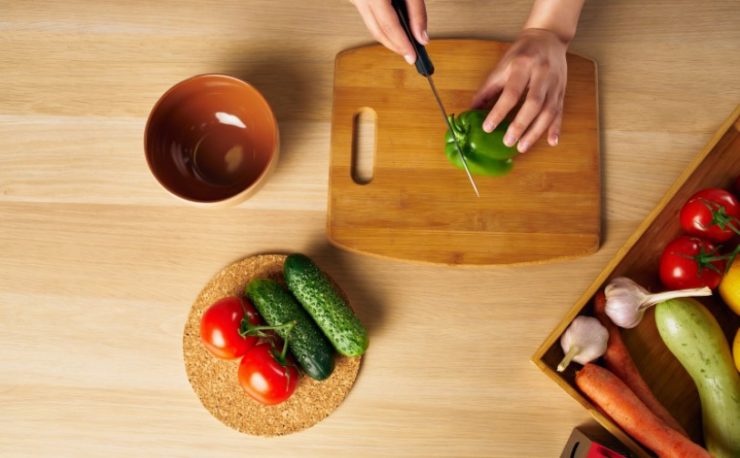
Keeping your cutting board clean may not be something that you think much about. But, it has a huge impact on food safety.
In a lot of professional kitchens, there are designated cutting boards for different categories of food. It goes something like this:
- Blue = Raw Seafood
- Yellow = Raw Poultry
- Red = Raw Meat
- Green = Fruits & Vegetables
- Brown = Ready To Eat Food
- White = Dairy
By using separate boards for different types of food, you’re much less likely to cross-contaminate and pass bacteria from one thing to another.
Not to mention the fact that in a restaurant, you can easily run each board through the dishwasher as frequently as you need. Each cycle only takes about a minute.
Now, that’s a great system when you’re working in a restaurant. But at home, having 6 different cutting boards or a commercial dishwasher just isn’t realistic for most people.
And since most people only use one or two cutting boards for everything, it becomes much more important to keep them clean. Especially when it comes to wooden cutting boards that you can’t just run through the dishwasher.
The truth is that daily cleaning with a bench scraper, soap, and water is all you need most of the time.
But, if you find that your wooden cutting board has picked up any stains or odors, a little salt scrub will work wonders.
How To Refresh A Cutting Board With Salt And Lemon
1. Mise En Place
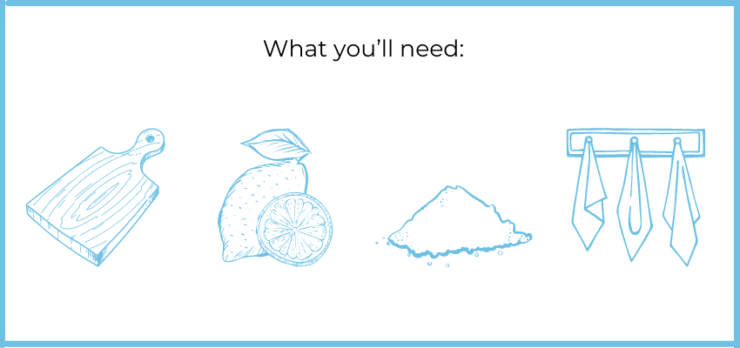
Before you get started, gather your mise en place. That means get everything you’ll need to get the job done before you start. Don’t worry, it’s not much.
- Coarse salt
- Half a lemon
- A bench scraper
- A kitchen towel (paper towels are fine as well)
2. Scrape
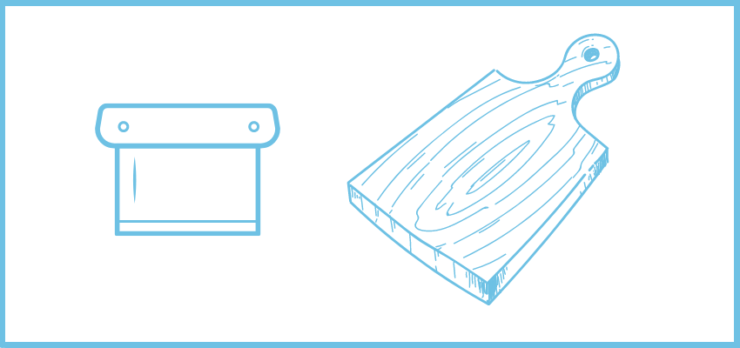
Start by giving your cutting board a good scrape with your bench scraper. This will get rid of any stuck-on bits of food and any other gunk that might be on top of the board.
3. Salt
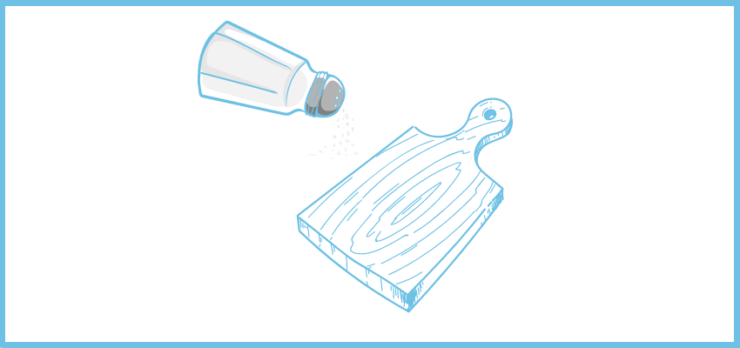
Liberally sprinkle salt on your cutting board. You want to use enough salt to create a meaningful amount of slurry, without all of the salt dissolving in the next step. Coarse salt works best.
4. Scour
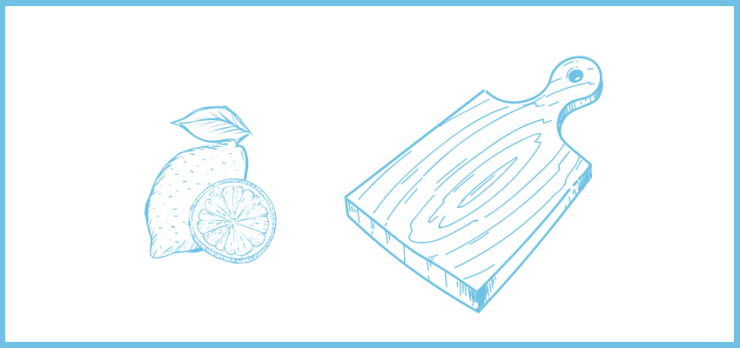
Take your half lemon and use it as a scouring pad on top of your salted cutting board. The juice from the lemon combined with the salt will make a very effective cleaning slurry.
After scouring, let the lemon juice and salt sit for 5-10 minutes before moving on to the next step.
Also, you don’t have to use fresh unsqueezed lemon for this.
Go ahead and squeeze most of the juice out beforehand and make yourself a refreshing beverage to reward all of your hard work.
5. Scrape
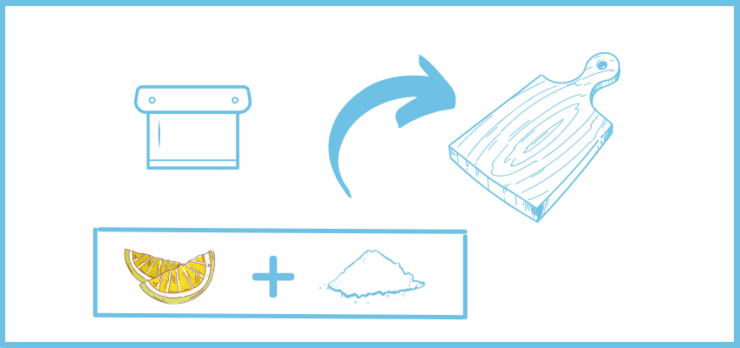
Next, use your bench scraper and give the board another thorough scrape. This will get rid of all of the salt, lemon juice, and grime that you just scrubbed out of your board.
6. Wipe
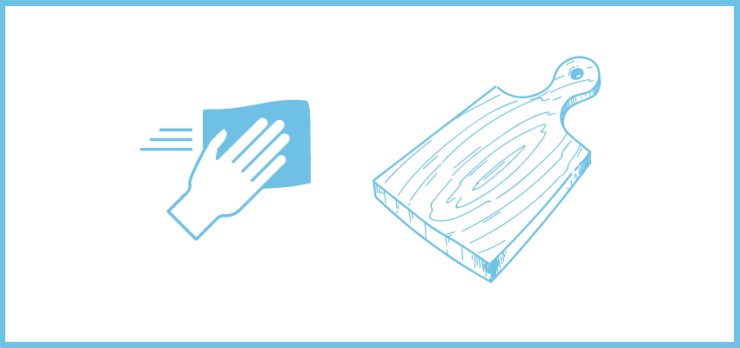
Finally, use a clean cloth or paper towel and give your cutting board one final wipe down. The bench scraper will have done most of the work, but a towel will get rid of any remaining salt and leave the board dry and ready to use.
Wood vs. Plastic Cutting Boards
Personally, I have one large wooden cutting board that sits on my counter at all times. It gets used for 90% of the food I prep and cook at home.
I even use it for quick raw meat prep tasks (gasp!).
For the most part, a bench scraper, soap, and water are all you need to keep your wooden cutting board clean. But never the dishwasher. That’s a quick way to cause your board to warp and crack.
And while some may refuse to place raw meat on a wooden cutting board, it’s been proven to be just as, if not safer than using a plastic one. The important thing is to simply clean them after using them with any ingredients that may contain unwanted bacteria.
For the other 10% of the time, I do use a plastic board.
For the most part, my plastic board works well when the wooden cutting board is already in use, or if I’m doing a lot of meat prep or breaking down fish.
And the main reason I use it for that type of protein prep is that it’s lighter and easier to clean in the sink. Plus, I can run it through the dishwasher if things get particularly messy.
When To Salt A Cutting Board
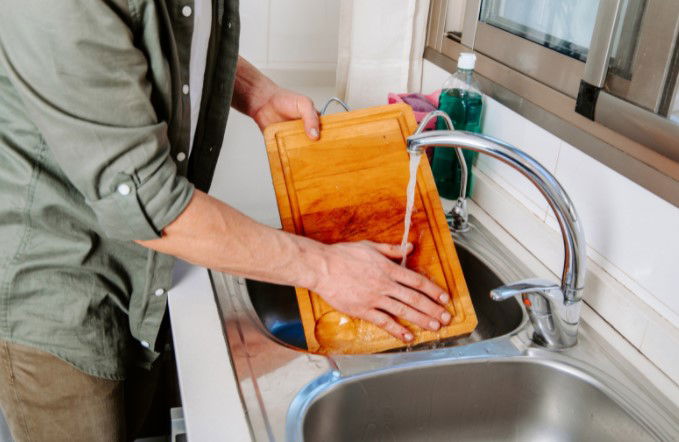
A majority of the time, a wooden cutting board can be cleaned just like most other things in the kitchen. Soap, water, and a sponge or cleaning brush.
The main reasons that you would turn to a deeper cleaning process like the salt and lemon technique, is if you notice your board has an “off” odor, or if something like beets leaves a stain that you’re not fond of.
Other than that, it’s not a bad idea to do it once a month or so just to keep your board looking and smelling good.
Special Care Tips For “After” Salting
After you salt your cutting board, it should look and smell pretty good. But you might also notice that it looks drier than normal. This is because the acid from the lemon will remove some of the oils from the board, while the salt pulls out excess moisture (a good thing).
So, this is the perfect time to apply a coating of oil to help seal the wood and keep it from warping or cracking.
You can use food-grade mineral oil or a cutting board-specific oil to do the job. Just slather your clean and dry board, let it sit for a couple of hours, and then wipe away any excess.
Get into the habit of repeating this regular cutting board maintenance about once a month. Do that and you and your cutting board will have a long and healthy future.
Frequently Asked Questions
Why Do You Salt A Wooden Cutting Board?
Salting a cutting board is a deep cleaning method using two, natural household ingredients. It’s a great way to refresh a wooden board that has developed any odors or has any stains.
Does Salt Disinfect Cutting Boards?
In most cases salt will not truly disinfect a cutting board. Salt can kill some bacteria by removing all of its moisture. But, the amount of salt and time required are difficult to measure at home, making it an unreliable method.
How Often Should I Replace My Cutting Board?
Replace your wooden cutting board if it becomes excessively warped or develops any deep gouges or cracks. Warped boards can be unstable and usafe to use with a knife, and gauges or cracks are prone to bacterial growth and mold.







